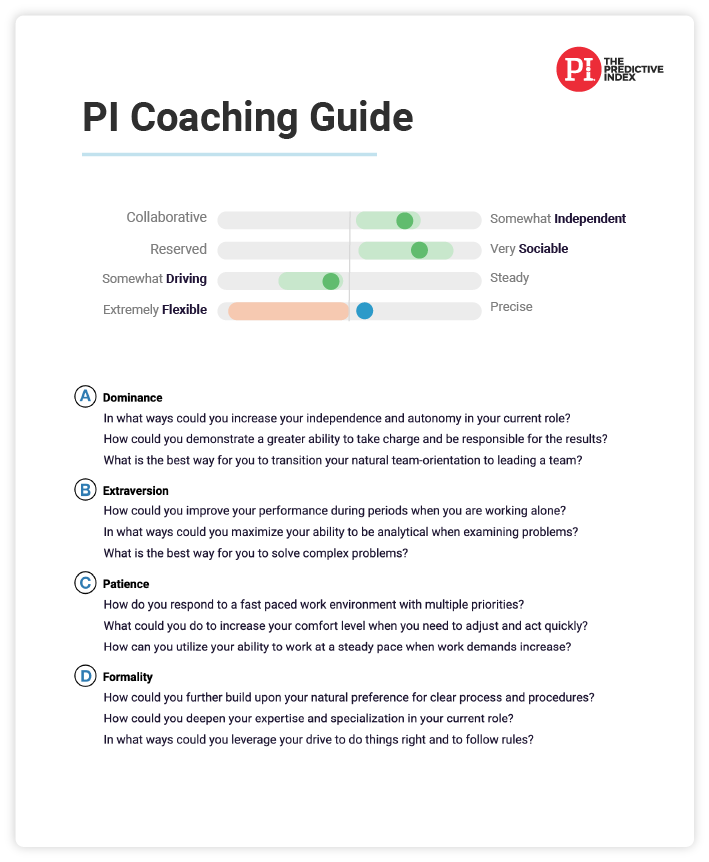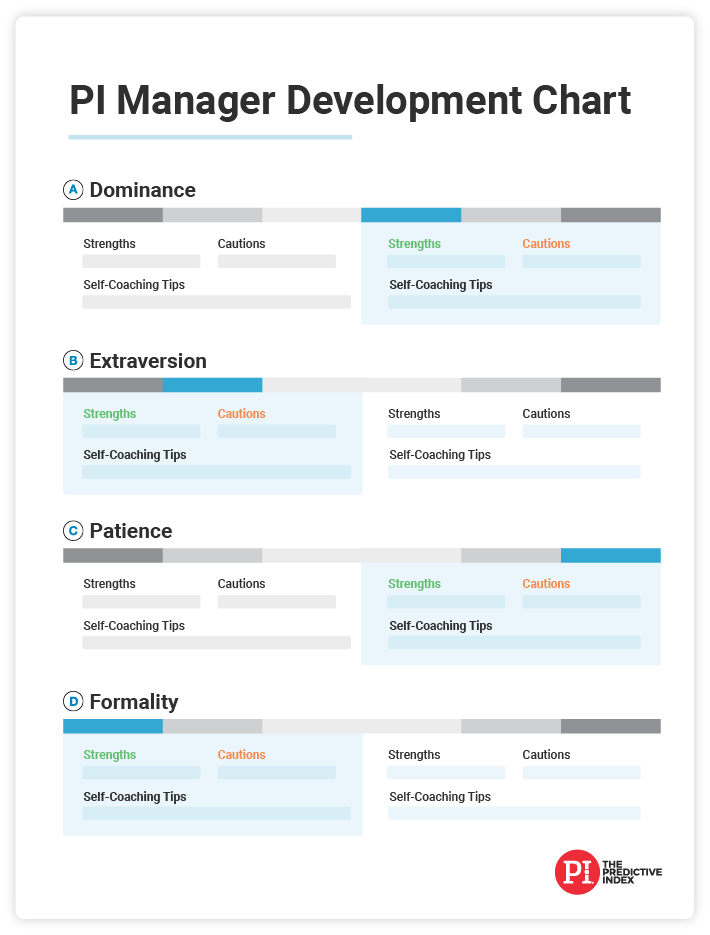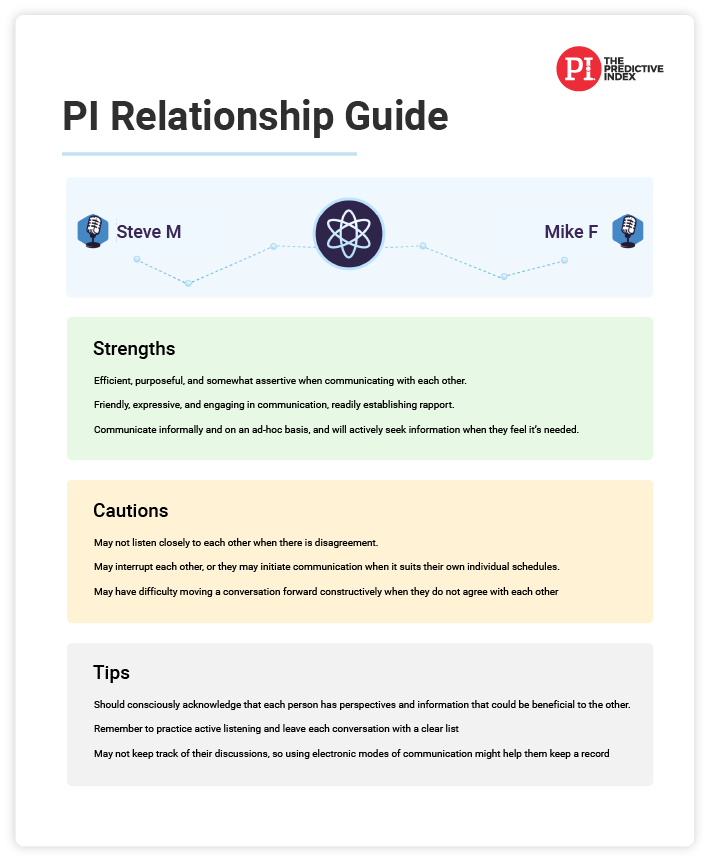The Inspire Phase of Talent Optimization
Learn how businesses train leaders at every level to achieve maximum performance from their workforce streamlined hiring process.
The Inspire phase of Talent Optimization is vital to building high-performing teams. By actively training and empowering managers to lead better, you can create a more profitable and productive workplace.
Inspire’s four components help to energize your people, rather than exhausting them.
However, before you can truly practice Inspire within your company, you need the necessary people data: namely, insights on their natural drives, needs, and behaviors. Without that data, the lack of self-awareness can cause workplace communication issues, leading to conflict, and worse, toxicity that damages the organization.
Thankfully, this talent optimization strategy gives employees insights that help them manage themselves and others better.
Create new jobs and career paths
A growing business will need to create new jobs to fulfill the emerging roles so the company can properly execute its strategy. Developing career paths for employees has a significant impact on business results. When an organization demonstrates a clear career path for its staff, it is able to attract higher performing, more dedicated candidates. To nurture and form talent, it is crucial to anticipate future needs as driven by the company’s strategy.
The following are important steps in creating new jobs and career paths:
Identify the new roles needed within the organization
To anticipate and identify future roles, a company should look at its business strategy. Every department manager should put together a forecast of the number and type of positions needed to successfully execute the strategy.
Craft compelling career paths and refresh employee roles
The Talent Optimization approach involves constantly reassessing the needs of the company based on changes to its overall business strategy. This type of career pathing is forward-looking and future-driven.

Our clients use this Predictive Index Coaching Guide to prepare future leaders for promotions
Share advancement opportunities within teams
High-performing employees love professional challenges and strive for growth opportunities. That’s why it is necessary to be forthcoming with advancement opportunities. Companies can demonstrate a commitment to employees as well as their business strategy by publicly displaying opportunities for advancement. It’s also important for the organization to become aware of promotable employees.
Develop capable leaders
Talent Optimization requires businesses to develop leaders at every level. This development drives employee performance and engagement.

Managers are often told to improve their soft skills, but rarely provided personalized action items such as in the full version of this Manager Development Chart.
Another key practice is to identify and evaluate leadership competencies and offer performance feedback within the context of the organization. Leaders should be working at every level of the company.
Effective leadership competencies are the main driver for high employee engagement. High engagement returns strong economic performance and people that excel, going above and beyond for the company.
The following actions will maximize leadership impact:
Create leader self-awareness
In leadership, self-awareness is crucial to fostering positive team dynamics at all levels. Impactful leaders are aware of their capabilities and their blind spots. They are constantly developing themselves to maximize their strengths and minimize their weaknesses.
Meet the needs of others
Having a unique and diverse set of employees requires a personalized approach. Managing employees is not “one size fits all.” Leaders should be aware of the needs of others in addition to having strong self-awareness.
Give performance feedback within the business context
Effective managers know they must drive business results while simultaneously developing their people. Neglecting either side of this equation leads to problems. It is important to provide specific feedback within the context of the business so that employees can clearly understand how they are meeting expectations, and where there is room for improvement.
Ensure productive peer relationships
Anytime people work together, there’s an opportunity for collaboration and growth. Likewise, there is potential for conflict. That’s why it is important to take a proactive approach to ensuring productive peer relationships.
The path to productive peer relationships includes:
Committing to awareness of self and others
Taking stock of each employee’s strengths and potential weaknesses in a thoughtful manner can help create awareness. This step was discussed in The Design Phase of Talent Optimization. When each person on a team understands how to bolster each other’s strengths and support peers in areas where they aren’t as strong, the whole team succeeds.
Acknowledge competing styles
It’s common to find two people in a work environment who are significantly different from each other in terms of their strengths and preferences. For instance, if one co-worker is methodical while the other is spontaneous, it’s important to acknowledge these competing styles. If this dynamic is not brought to the surface, it could be a breeding ground for frustration and disunity. It’s crucial to remind both parties that neither style is correct or incorrect. Competing styles are simply different and should be equally respected and understood.
Address competing goals
Sometimes, two team members may be working to attain opposite goals that compete with one another. For example, if one employee is striving for ingenuity, innovation, and adaptation while another employee is working to maintain tradition, stability, and control, this may be a recipe for friction. One person is working to discover new ways of achieving results, while the other is trying to adhere to high levels of efficiency, quality, and predictability. These goals are competing with one another and could have a negative effect with the interpersonal dynamic if not addressed.
Pre-negotiate the best ways of working together
The best time to set the tone for a productive working relationship is in the beginning. Before a team works together, the above steps can be effective in setting expectations and cultivating awareness. Once everyone has an understanding of each person’s strengths and any competing styles or goals, the team can decide how best to work together.
If, down the road, conflict arises, it is possible to initiate a “reset” of the relationship. This involves revisiting the strength of each person while addressing competing styles and goals in a neutral setting. Employees may be invited to redefine and recommit to the optimal working relationship and thoughtfully hold each other accountable in honoring their arrangement.

Reinforce company culture
Peter Drucker once said, “Culture eats strategy for breakfast.” In other words, an empowering culture is the most effective path toward a company’s success.
When culture is aligned with business strategy, it creates a perpetual cycle of productivity, both for the individual and collective – but this culture must be monitored and managed. Similar to a garden, weeds of toxic culture can sprout up and spread through an organization, choking productivity and employee engagement. Individual potential will not have access to the proper sunlight and nutrients to thrive. The team will suffer, and high performers will leave the company.
That’s why it is important to diligently tend the garden of company culture.
There are four ways to reinforce company culture:
- Continuously communicate cultural norms.
- Anticipate and address conflicting behaviors and styles.
- Encourage employee recognition of culture champions.
- Reward and reinforce desired behaviors to highlight their alignment with company culture.
If companies want to maximize the talent of their teams, particularly those that are high performing, it’s essential that they develop systems and processes to Inspire. Once inspired to action, individuals become resilient, self-aware leaders that advocate for healthier work environments and increase a company’s chance of success.
Could your company benefit from Inspire?
Inspire provides an effective, structured way to develop employees and train leaders. It allows companies to save money by fostering tomorrow’s leaders within the organization rather than hiring from the outside.
Having a pipeline of future managers often reduces their training costs and positions companies for future success by creating a clear understanding of each worker’s capacity for work.
Inspire emphasizes connection, which builds trust and transparency between team members, which leads to better relationships with coworkers. And without the fear of workload being shifted to other teams, it then allows for increased productivity across the board.
If you would like to learn more about how we are helping organizations utilize talent optimization to create a competitive advantage for their business, give us a call, or drop us an email, we would welcome the opportunity to learn more about your business and the challenges you are facing.
About Jeff
Jeff has over 30 years of strategic planning, business development, and business transformation leadership experience. Having worked with mid-market, closely-held and family-owned businesses his entire career Jeff has a unique understanding of how these enterprises operate and the challenges they face.
He is passionate about working with business leaders to build strong cultures while developing and executing strategies that deliver exceptional results that benefit all the company’s stakeholders. Jeff’s hands-on approach to working with companies begins with a commonsense approach to strategy development.
With extensive experience in organizational turnaround and growth Jeff follows a defined process (disciplined, focused, intentional) to guide clients from strategy to execution. His experience covers a multitude of industries, with an in-depth understanding of automotive manufacturing.
Jeff holds a Master’s in Business Administration from the Capital University School of Management and earned a Bachelor of Arts in Business Administration and Management from Ohio Dominican University.



